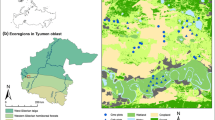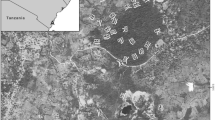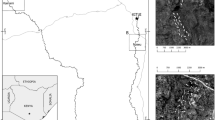Abstract
In the tropics vast areas of natural forests are being converted into plantations. The magnitude of the resulting loss in arthropod biodiversity and associated ecosystem services represents a significant topic of research. In this study we contrasted the abundance, species richness and faunal turnover of butterflies, resident butterflies (i.e., whose host plants were ascertained to occur in the habitats studied) and termites between small (average 4.3 ha) 20+ year old exotic plantations (teak and Terminalia), native plantations (Cedro espino), and an old growth forest in Panama. We used Pollard walks and manual search to quantify the abundance or occurrence of butterflies and termites, respectively. In 2014 we observed 4610 butterflies representing 266 species and 108 termite encounters (out of 160 quadrats) representing 15 species. Butterflies were more abundant and diverse in plantations than in the forest, whereas this pattern was opposite for resident butterflies and termites. There was marked faunal turnover between plantations and forest. We conclude that (a) the magnitude of faunal changes between forest and plantations is less drastic for termites than for butterflies; (b) resident butterfly species are more impacted by the conversion of forest to plantations than all butterflies, including transient species; and (c) species richness does not necessarily decrease in the series forest > native > exotic plantations. Whereas there are advantages of studying more tractable taxa such as butterflies, the responses of such taxa can be highly unrepresentative of other invertebrate groups responsible for different ecological services.




Similar content being viewed by others
References
Anderson-Teixeira KJ, Davies SJ, Bennett AC et al (2014) CTFS-ForestGEO: a worldwide network monitoring forests in an era of global change. Glob Change Biol. doi:10.1111/gcb.12712
Anselin L (1988) Spatial econometrics: methods and models. Kluwer Academic Publishers, Boston
Attignon SE, Lachat T, Sinsin B et al (2005) Termite assemblages in a West-African semi-deciduous forest and teak plantations. Agric Ecosyst Environ 110:318–326
Barlow J, Overal WL, Araujo IS et al (2007) The value of primary, secondary and plantation forests for fruit-feeding butterflies in the Brazilian Amazon. J Appl Ecol 44:1001–1012
Basset Y, Novotny V, Miller SE et al (1998) Assessing the impact of forest disturbance on tropical invertebrates: some comments. J Appl Ecol 35:461–466
Basset Y, Eastwood R, Sam L et al (2011) Comparison of rainforest butterfly assemblages across three biogeographical regions using standardized protocols. J Res Lep 44:17–28
Basset Y, Eastwood R, Sam L et al (2013) Cross-continental comparisons of butterfly assemblages in rainforests: implications for biological monitoring. Insect Conserv Divers 6:223–233
Basset Y, Barrios H, Segar S et al (2015) The butterflies of Barro Colorado Island, Panama: local extinction since the 1930s. PLoS One 10:e0136623. doi:10.1371/journal.pone.0136623
Bignell DE, Eggleton P (2000) Termites in ecosystems. In: Abe T, Bignell DE, Higashi M (eds) Termites: evolution, sociality, symbiosis, ecology. Kluwer Academic Publishers, Dordrecht, pp 363–387
Bonebrake TC, Ponisio LC, Boggs CL et al (2010) More than just indicators: a review of tropical butterfly ecology and conservation. Biol Conserv 143:1831–1841
Brockerhoff EG, Jactel H, Parrotta JA et al (2008) Plantation forests and biodiversity: oxymoron or opportunity? Biodiv Conserv 17:925–951
Brockerhoff EG, Jactel H, Parrotta JA et al (2013) Role of eucalypt and other planted forests in biodiversity conservation and the provision of biodiversity-related ecosystem services. For Ecol Manag 301:43–50
Cardinale BJ, Duffy JE, Gonzalez A et al (2012) Biodiversity loss and its impact on humanity. Nature 486:59–67
Castellanos MC, Stevenson PR (2011) Phenology, seed dispersal and difficulties in natural recruitment of the canopy tree Pachira quinata (Malvaceae). Rev Biol Trop 59:921–933
Colwell RK (2009) EstimateS: statistical estimation of species richness and shared species from samples. version 8.50. user’s guide and application. University of Connecticut, Storrs
Condit R (1998) Tropical forest census plots. Springer, Texas
Condit R, Perez R, Lao S et al (2005) Geographic ranges and b-diversity: discovering how many tree species there are where. Biologiske Skrifter 55:57–71
Curtis RJ, Brereton TM, Dennis RL et al (2015) Butterfly abundance is determined by food availability and is mediated by species traits. J Appl Ecol 52:1676–1684
Davis AJ, Sutton SL (1998) The effects of rainforest canopy loss on arboreal dung beetles in Borneo: implications for the measurement of biodiversity in derived tropical ecosystems. Divers Distrib 4:167–173
Didham RK, Ghazoul J, Stork NE et al (1996) Insects in fragmented forests: a functional approach. Tree 11:255–260
Donovan SE, Eggleton P, Bignell DE (2001) Gut content analysis and a new feeding group classification of termites. Ecol Entomol 26:356–366
Eggleton P (1999) Termite species description rates and the state of termite taxonomy. Insects Soc 46:1–5
Eggleton P, Bignell DE, Sands WA et al (1995) The species richness of termites (Isoptera) under differing levels of forest disturbance in the Mbalmayo Forest Reserve, southern Cameroon. J Trop Ecol 11:85–98
Ghazoul J (2002) Impact of logging on the richness and diversity of forest butterflies in a tropical dry forest in Thailand. Biodiv Conserv 11:521–541
Gotelli NJ, Chao A (2013) Measuring and estimating species richness, species diversity, and biotic similarity from sampling data. In: Levin SA (ed) Encyclopedia of biodiversity, 2nd edn. Academic Press, Waltham, pp 195–211
Hamer KC, Hill JK (2000) Scale-dependent effects of habitat disturbance on species richness in tropical forests. Conserv Biol 14:1435–1440
Hamilton AJ, Novotny V, Waters EK et al (2013) Estimating global arthropod species richness: refining probabilistic models using probability bound analysis. Oecologia 171:357–365
Holloway JD, Kirk-Spriggs AH, Chey VK (1992) The response of some rain forest insect groups to logging and conversion to plantation. Philos Trans R Soc Lond B 335:425–436
Horner-Devine MC, Daily GC, Ehrlich PR, Boggs CL (2003) Countryside biogeography of tropical butterflies. Conserv Biol 17:168–177
Isbell F, Calcagno V, Hector A et al (2011) High plant diversity is needed to maintain ecosystem services. Nature 477:199–202
Jones DT, Eggleton P (2000) Sampling termite assemblages in tropical forests: testing a rapid biodiversity assessment protocol. J Appl Ecol 37:191–203
Jones DT, Susilo FX, Bignell DE et al (2003) Termite assemblage collapse along a land-use intensification gradient in lowland central Sumatra, Indonesia. J Appl Ecol 40:380–391
Koh LP, Wilcove DS (2008) Is oil palm agriculture really destroying tropical biodiversity? Conserv Lett 1:60–64
Leather SR (2009) Taxonomic chauvinism threatens the future of entomology. Biologist 56:10–13
Longino JT (2000) What to do with the data? In: Agosti D, Majer JD, Alonson LE, Schultz TR (eds) Ants. Standard methods for measuring and monitoring biodiversity. Smithsonian Institution Press, Washington, pp 186–203
Lucey JM, Hill JK (2011) Spillover of insects from rain forest into adjacent oil palm plantations. Biotropica 44:368–377
Luke SH, Fayle TM, Eggleton P et al (2014) Functional structure of ant and termite assemblages in old growth forest, logged forest and oil palm plantation in Malaysian Borneo. Biodiv Conserv 23:2817–2832
Novotny V, Basset Y (2000) Rare species in communities of tropical insect herbivores: pondering the mystery of singletons. Oikos 89:564–572
Nummelin M, Fuersch H (1992) Coccinellids of the Kibale Forest, Western Uganda: a comparison between virgin and managed sites. Trop Zool 5:155–166
Oksanen J, Blanchet FG, Kindt R et al (2011) Vegan: community ecology package. R package version 1.17-6. R Foundation for Statistical Computing, Vienna
Orwa C (2010) Agroforestree Database 4.0: a tree reference and selection guide. World Agroforestry Centre. http://www.worldagroforestry.org/treedb/. Accessed 8 Nov 2015
Pellet J (2008) Seasonal variation in detectability of butterflies surveyed with Pollard walks. J Insects Conserv 12:155–162
Pollard E (1977) A method for assessing changes in the abundance of butterflies. Biol Conserv 12:115–153
Rangel TF, Diniz-Filho JAF, Bini LM (2010) SAM: a comprehensive application for spatial analysis in macroecology. Ecography 33:1–5
Robbins RK (1982) Comparison of butterfly diversity in the Neotropical and Oriental regions. J Lep Soc 46:298–300
Roisin Y, Leponce M (2004) Characterizing termite assemblages in fragmented forests: a test case in the Argentinian Chaco. Aust Ecol 29:637–646
Rudman P, Da Costa EWB, Gay FJ et al (1958) Relationship of tectoquinone to durability in Tectona grandis. Nature 181:721–722
Sparrow HR, Sisk TD, Ehrlich PR et al (1994) Techniques and guidelines for monitoring Neotropical butterflies. Conserv Biol 8:800–809
Speight MR, Intachat J, Khen CV et al (2003) Influences of forest management on insects. In: Basset Y, Novotny V, Miller SE, Kitching RL (eds) Arthropods of tropical forests: spatio-temporal dynamics and resource use in the canopy. Cambridge University Press, Cambridge, pp 380–393
Spitzer K, Jaros J, Havelka J et al (1997) Effect of small-scale disturbance on butterfly communities of an Indochinese montane rainforest. Biol Conserv 80:9–15
Stephen C, Sánchez R (2014) Species richness and relative species abundance of Nymphalidae (Lepidoptera) in three forests with different perturbations in the North-Central Caribbean of Costa Rica. Rev Biol Trop 62:919–928
Swift MJ, Izac AM, van Noordwijk M (2004) Biodiversity and ecosystem services in agricultural landscapes—are we asking the right questions? Agric Ecosyst Environ 104:113–134
Ter Braak CJF, Smilauer P (2003) CANOCO reference manual and user’s guide to canoco for windows: software for canonical community ordination (version 4.52). Microcomputer Power, Ithaca
Vlasanek P, Sam L, Novotny V (2013) Dispersal of butterflies in a New Guinea rainforest: using mark–recapture methods in a large, homogeneous habitat. Ecol Entomol 38:560–569
Windsor DM (1990) Climate and moisture variability in a tropical forest: long-term records from Barro Colorado Island, Panama. Smithsonian Institution Press, Washington
Acknowledgments
Bob Robbins, Andy Warren, Annette Aiello, Yves Roisin, Thomas Bourguignon and Rudolf Scheffrahn provided expert opinions on butterfly and termite taxonomy. Jefferson Hall and Estrella Yanguas kindly helped to organize the project and shared their vegetation data. Fieldwork was funded by Argos and ForestGEO, collecting permits were granted by the Autoridad Nacional del Ambiente de Panamá. Grants from the Smithsonian Institution Barcoding Opportunity FY012, FY013, FY014 and in-kind help from the Canadian Centre for DNA Barcoding via Paul Hebert and Alex Borisenko at the Biodiversity Institute of Ontario allowed the sequencing of the butterfly and termite specimens. YB was supported by Czech Science foundation GAČR grant 14-36098G. YB and HB are members of the Sistema Nacional de Investigación, SENACYT, Panama. Isabelle Bachy helped with the preparation of the figures. Cecilia Dahlsjö, Alan Andersen and an anonymous reviewer greatly helped to improve the manuscript.
Author information
Authors and Affiliations
Corresponding author
Additional information
Communicated by Akihiro Nakamura.
This article belongs to the Topical Collection: Forest and plantation biodiversity.
Electronic supplementary material
Below is the link to the electronic supplementary material.
Rights and permissions
About this article
Cite this article
Basset, Y., Barrios, H., Ramirez, J.A. et al. Contrasting the distribution of butterflies and termites in plantations and tropical forests. Biodivers Conserv 26, 151–176 (2017). https://doi.org/10.1007/s10531-016-1231-6
Received:
Revised:
Accepted:
Published:
Issue Date:
DOI: https://doi.org/10.1007/s10531-016-1231-6




